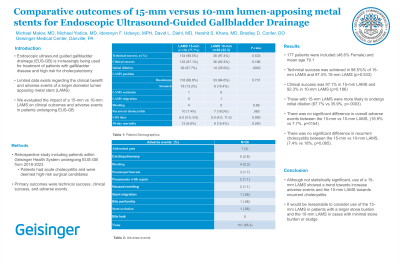Monday Poster Session
Category: Interventional Endoscopy
P2764 - Comparative Outcomes of Lumen Apposing Metal Stent 15-mm versus 10-mm for Endoscopic Ultrasound-Guided Gallbladder Drainage
Monday, October 28, 2024
10:30 AM - 4:00 PM ET
Location: Exhibit Hall E

Has Audio

Michael Makar, MD
Geisinger Health System
Danville, PA
Presenting Author(s)
Michael Makar, MD1, Michael Yodice, MD1, Idorenyin Udoeyo, MPH1, David L. Diehl, MD1, Harshit S.. Khara, MD, FACG2, Bradley D.. Confer, DO1
1Geisinger Health System, Danville, PA; 2Geisinger Medical Center, Danville, PA
Introduction: Endoscopic ultrasound-guided gallbladder drainage (EUS-GB) using a lumen-apposing metal stents (LAMS) has become an important treatment option for patients with cholecystitis who are not surgical candidates. Limited data exists regarding the clinical benefits and adverse events of a larger diameter LAMS. This study aimed to compare the safety and clinical outcomes of 15-mm LAMS vs 10-mm LAMS in EUS-GB.
Methods: This was a retrospective study of patients who underwent EUS-GB between 2018 to 2023 within a large academic hospital system. Data was collected regarding procedural characteristics, clinical and technical success, adverse events, LAMS size, length of stay (LOS) and overall mortality. Technical success was defined as successful deployment of the LAMS to the intended location. Clinical success was defined as improvement in patient symptom and lab parameters. Groups were compared using a Chi-square, Fisher’s exact test, an independent two-sample t-test and Mann-Whitney test, where appropriate. A p< 0.05 was considered significant.
Results: A total of 177 patients were included (48.6% female and mean age 79.1). The 15-mm LAMS was used in 136 patients (77.7%) and 10mm in the remainder. Technical success was achieved in 98.5% of those with 15-mm LAMS vs 97.4% in 10-mm (p=0.533). Clinical success was achieved in 15-mm LAMS 97.1% vs 92.3% (p=0.186). The 15mm LAMS were more likely to undergo dilation (67.7% vs 35.9%, p=0.003). The 15-mm LAMS had a trend towards increased overall adverse events (16.9% vs 7.7%, p=0.154) and bleeding (2.3% vs 0% (p=0.9), although this was not statistically significant. The 10-mm LAMS had a trend towards recurrent cholecystitis (18% vs 7.4%, p=.065), although not statistically significant. There was no difference in LOS or mortality.
Discussion: Use of a 15-mm LAMS showed a trend towards increase adverse events and the 10-mm LAMS towards recurrent cholecystitis. Although not statistically significant, it is likely that a type II error exists. Further studies are needed to explore the differences and outcomes in LAMS size for EUS-GB. Until those studies are available, one must balance the risk of adverse events versus recurrent cholecystitis. It seems reasonable to use the 15 mm LAMS in patients with a large stone burden, and the 10 mm LAMS in cases with a minimal amount of stones or sludge.
Note: The table for this abstract can be viewed in the ePoster Gallery section of the ACG 2024 ePoster Site or in The American Journal of Gastroenterology's abstract supplement issue, both of which will be available starting October 27, 2024.
Disclosures:
Michael Makar, MD1, Michael Yodice, MD1, Idorenyin Udoeyo, MPH1, David L. Diehl, MD1, Harshit S.. Khara, MD, FACG2, Bradley D.. Confer, DO1. P2764 - Comparative Outcomes of Lumen Apposing Metal Stent 15-mm versus 10-mm for Endoscopic Ultrasound-Guided Gallbladder Drainage, ACG 2024 Annual Scientific Meeting Abstracts. Philadelphia, PA: American College of Gastroenterology.
1Geisinger Health System, Danville, PA; 2Geisinger Medical Center, Danville, PA
Introduction: Endoscopic ultrasound-guided gallbladder drainage (EUS-GB) using a lumen-apposing metal stents (LAMS) has become an important treatment option for patients with cholecystitis who are not surgical candidates. Limited data exists regarding the clinical benefits and adverse events of a larger diameter LAMS. This study aimed to compare the safety and clinical outcomes of 15-mm LAMS vs 10-mm LAMS in EUS-GB.
Methods: This was a retrospective study of patients who underwent EUS-GB between 2018 to 2023 within a large academic hospital system. Data was collected regarding procedural characteristics, clinical and technical success, adverse events, LAMS size, length of stay (LOS) and overall mortality. Technical success was defined as successful deployment of the LAMS to the intended location. Clinical success was defined as improvement in patient symptom and lab parameters. Groups were compared using a Chi-square, Fisher’s exact test, an independent two-sample t-test and Mann-Whitney test, where appropriate. A p< 0.05 was considered significant.
Results: A total of 177 patients were included (48.6% female and mean age 79.1). The 15-mm LAMS was used in 136 patients (77.7%) and 10mm in the remainder. Technical success was achieved in 98.5% of those with 15-mm LAMS vs 97.4% in 10-mm (p=0.533). Clinical success was achieved in 15-mm LAMS 97.1% vs 92.3% (p=0.186). The 15mm LAMS were more likely to undergo dilation (67.7% vs 35.9%, p=0.003). The 15-mm LAMS had a trend towards increased overall adverse events (16.9% vs 7.7%, p=0.154) and bleeding (2.3% vs 0% (p=0.9), although this was not statistically significant. The 10-mm LAMS had a trend towards recurrent cholecystitis (18% vs 7.4%, p=.065), although not statistically significant. There was no difference in LOS or mortality.
Discussion: Use of a 15-mm LAMS showed a trend towards increase adverse events and the 10-mm LAMS towards recurrent cholecystitis. Although not statistically significant, it is likely that a type II error exists. Further studies are needed to explore the differences and outcomes in LAMS size for EUS-GB. Until those studies are available, one must balance the risk of adverse events versus recurrent cholecystitis. It seems reasonable to use the 15 mm LAMS in patients with a large stone burden, and the 10 mm LAMS in cases with a minimal amount of stones or sludge.
Note: The table for this abstract can be viewed in the ePoster Gallery section of the ACG 2024 ePoster Site or in The American Journal of Gastroenterology's abstract supplement issue, both of which will be available starting October 27, 2024.
Disclosures:
Michael Makar indicated no relevant financial relationships.
Michael Yodice indicated no relevant financial relationships.
Idorenyin Udoeyo indicated no relevant financial relationships.
David Diehl: Castle Biosciences – Consultant.
Harshit Khara: Boston Scientific – Consultant. Castle Biosciences – Consultant. ConMed – Consultant. Cook Medical – Consultant. Medtronic – Consultant. Neptune Medical – Consultant. Olympus America – Consultant. Pentax – Consultant.
Bradley Confer: Boston Scientific Corporation – Consultant. Exact Sciences – Advisory Committee/Board Member, FDA advisory panel.
Michael Makar, MD1, Michael Yodice, MD1, Idorenyin Udoeyo, MPH1, David L. Diehl, MD1, Harshit S.. Khara, MD, FACG2, Bradley D.. Confer, DO1. P2764 - Comparative Outcomes of Lumen Apposing Metal Stent 15-mm versus 10-mm for Endoscopic Ultrasound-Guided Gallbladder Drainage, ACG 2024 Annual Scientific Meeting Abstracts. Philadelphia, PA: American College of Gastroenterology.
